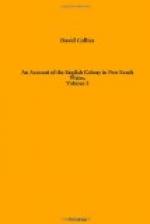In the male, just at the setting-on of the heel, there is a strong crooked spur, half an inch long, with a sharp point, which has a joint between it and the foot, and is capable of motion in two directions. When the point of it is brought close to the leg, the spur is almost completely concealed among the hair; when directed outwards, it projects considerably, and is very conspicuous. It is probably by means of these spurs, or hooks, that the female is kept from withdrawing herself in the act of copulation; since they are very conveniently placed for laying hold of her body on that particular occasion. This spur is peculiar to the male.
The tail, in its general shape, is very similar to that of the beaver.
Of the internal parts, the tongue is two inches long, lying in the hollow between the two jaws, but not projecting any way into the bill, being confined to its situation, except a very small portion at the tip.
The ribs are sixteen in number, and are united by a very elastic ligamentous substance, which admits of their being pulled to some distance; so that the capacity of the chest can undergo a very unusual degree of change.
The heart is situated in the middle line of the chest, its apex pointing to the sternum, and is inclosed in a strong pericardium: it is made up of two aurieles and two ventricles.
The lungs are large in size, corresponding to the capacity of the chest. Instead of a portion of them being above the heart, as in other animals, the heart may be said to be above the lungs; for they only embrace its sides, and do not surround its upper surface, but extend downwards into the more moveable part of the cavity of the chest.
The stomach is smaller than in most other animals; in this respect resembling the true stomach of birds.
The liver is composed of four lobes, besides the small lobe, or lobulus spigelii. The gall bladder is in the usual situation, and of the common size.
The skull is rather flattened upon the upper surface: its cavity is capacious, and there is a boney process projecting from the cranium, in place of the falx or dura mater. This Mr. Home believes is not the case in any other quadruped.
The olfactory nerves are small, and so are the optic nerves; but the fifth pair, which supply the muscles of the face, are uncommonly large. From this circumstance, we should be led, Mr. Home says, to believe, that the sensibility of the different parts of the bill is very great, and therefore that it answers the purpose of a hand, and is capable of nice discrimination in its feeling.
The eye is very small, and is nearly spherical. There is a membrana nictitans; and the eyelid is very loose upon the eyeball: it is probably capable of great dilatation and contraction.
The membrana tympani is larger than in other quadrupeds of the same size.
The organs of generation in this animal have several peculiarities of a very extraordinary nature.




